Panama Pacific Exposition Commemoratives
The Panama Pacific International Exposition took place from February 20 to December 4, 1915. Also known as the San Francisco Worlds Fair, its purpose was to honor the completion of the Panama Canal as well as showcase to the world how the city regained prominence after the earthquake that shook it in 1906. The fair, with its many buildings and exhibits was built on a 635 acre site, now known as the Marina. Among the exhibits included the Liberty Bell and the first Steam Locomotive. Several buildings were constructed to house different exhibits. Some of these included The Tower of Jewels, which was the centerpiece of the fair, the Agriculture Palace, the Liberal Arts Palace, and the Transportation Palace, only to name a few.
The coin program for the Panama Pacific Exposition was conceived by Farran Zerbe, a notable dealer and entrepreneur at the time. He suggested five different coins to commemorate the event and was given the right to market and distribute them. These coins include a silver half dollar, gold dollar, gold quarter-eagle, and two huge fifty-dollar gold coins. One of the fifty-dollar pieces was to be round and one octagonal. A detailed description of each coin is listed below.
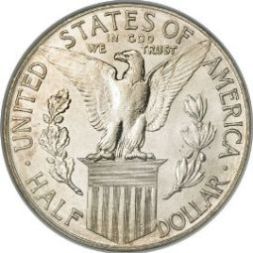
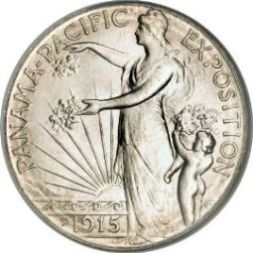
For the silver half dollar, the obverse shows Columbia scattering flowers, the Golden Gate Bridge in the background, and the sun rising in the distance. Also, included is a cherub at Columbia’s side. The inscriptions on the front read “PANAMA PACIFIC EXPOSITION” and the date of 1915.
The reverse of the coin features the shield of the United States topped by an American eagle and flanked by an oak branch on one side and an olive branch on the other. The oak was to symbolize strength and the olive to convey peace. The legend on the back of the coin reads “UNITED STATES OF AMERICA”, “HALF DOLLAR” and “IN GOD WE TRUST”.
Dates Minted: 1915
Authorization: Act of January 16, 1915
Authorized mintage: 200,000
Amount struck: 60,030
Actual distribution: 27,134
Designer: Charles Barber
Weight: 12.5 grams
Composition: 90% Silver, 10% Copper
Diameter: 30.6 mm
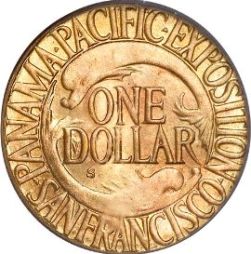
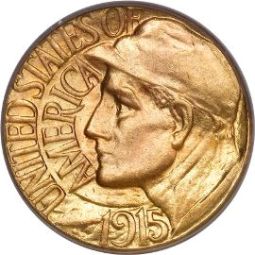
The next coin in the panama pacific program was the gold dollar. The obverse of this coin is fairly basic; it shows an image intended to be a laborer that worked on the Panama Canal. The inscription to the left reads “UNITED STATES OF AMERICA” and the date 1915 at the bottom.
The reverse has two dolphins symbolizing the meeting of the two oceans. Inscriptions on the reverse include “PANAMA PACIFIC EXPOSITION”, “SAN FRANCISCO” and the denomination “ONE DOLLAR”.
Dates Minted: 1915
Authorization: Act of January 16, 1915
Authorized mintage: 25,000
Amount struck: 25,034 includes 34 assay coins
Actual distribution: 15,000
Designer: Charles Keck
Weight: 1.67 grams
Composition: 90% Gold, 10% Copper
Diameter: 15 mm
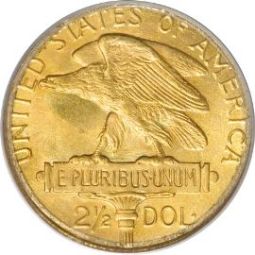
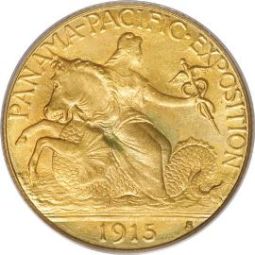
The obverse of the quarter eagle shows a very symbolic depiction of the goddess Columbia. She is riding sidesaddle on the back of a Greek mythological seahorse called a hippocampus. This creature has the front half of a horse and the tail of a fish. In her left hand is held a caduceus signifying the medical profession and symbolic of the fight against yellow fever and malaria as the canal was being built. The inscriptions on the front of the coin read “PANAMA PACIFIC EXPOSITION” and the date of 1915.
The reverse of this coin depicts an eagle perched on a plaque that is inscribed “E PLURIBUS UNUM”. The other inscriptions on the reverse read “UNITED STATES OF AMERICA” and the denomination “2-1/2 DOL”.
Dates Minted: 1915
Authorization: Act of January 16, 1915
Authorized mintage: 10,000
Amount struck: 10,017 includes 17 assay coins
Actual distribution: 6,749
Designer: Charles Barber (obv), George T. Morgan (rev)
Weight: 4.18 grams
Composition: 90% Gold, 10% Copper
Diameter: 18 mm
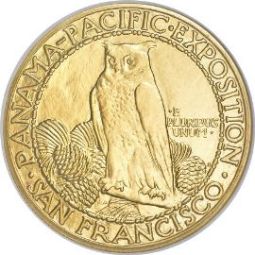
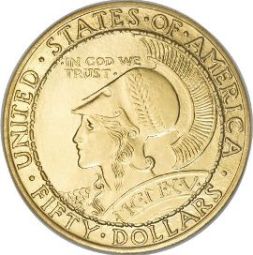
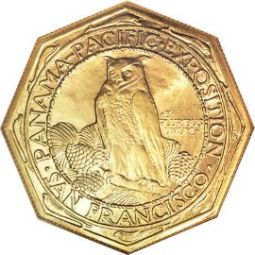
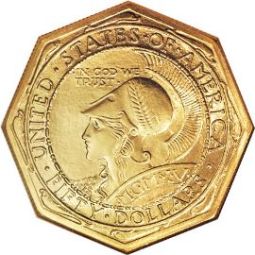
The final two coins in the program are massive fifty-dollar coins. They are similar in design with only minimal differences, one being round and the other octagonal. The obverse of both features a helmeted head of Minerva, the Roman goddess of war, wisdom, skill and agriculture. Below the portrait is the inscription of the date written in Roman Numerals “MCMXV” for 1915. Other inscriptions on the obverse include “UNITED STATES OF AMERICA”, “IN GOD WE TRUST” and the denomination “FIFTY DOLLARS”.
The reverse of both round and octagonal panama pacific coins shows an image of an owl sitting in a Ponderosa Pine tree surrounded with pinecones. The owl is intended to symbolize wisdom and intellect. The inscriptions on the back of these coins read “PANAMA PACIFIC EXPOSITION”, “SAN FRANCISCO” and “E PLURIBUS UNUM”.
The most obvious difference between the two coins is the shape. Beyond that, the design on the octagonal is slightly smaller to make room for the border lettering. Also, the octagonal coin has eight dolphins in the angles on both sides as illustrated in the images above.
Dates Minted: 1915
Authorization: Act of January 16, 1915
Authorized mintage: 3,000 (1,500 each)
Amount struck: Round 1,510 includes 10 assay coins
Amount struck: Octagonal 1,509 includes 9 assay coins
Actual distribution: Round 483
Actual distribution: Octagonal 645
Designer: Robert Aitken
Weight: 83.55 grams (Over 2 ½ ounces!)
Composition: 90% Gold, 10% Copper
Diameter: 50.8 mm
Back to Coin Collecting Homepage


